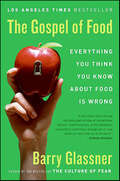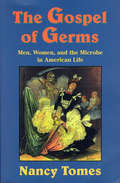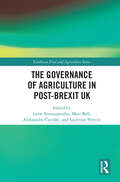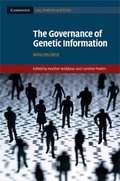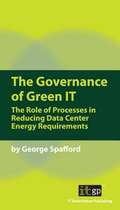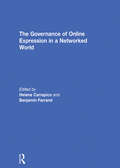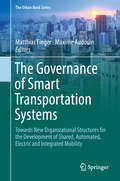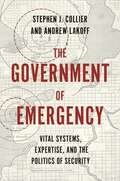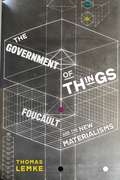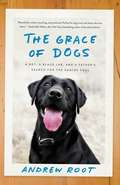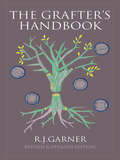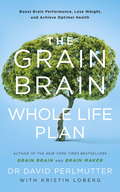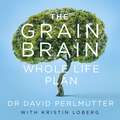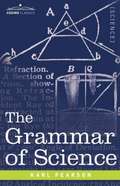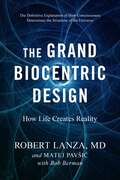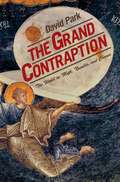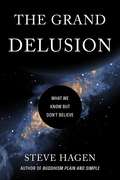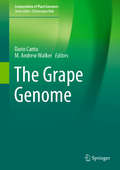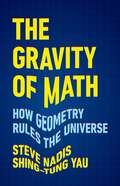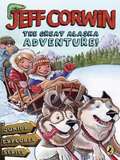- Table View
- List View
The Gospel of Food: Why We Should Stop Worrying and Enjoy What We Eat
by Barry GlassnerFor many Americans, eating is a religion. We worship at the temples of celebrity chefs. We raise our children to believe that certain foods are good and others are bad. We believe that if we eat the right foods, we will live longer, and if we eat in the right places, we will raise our social status. Yet what we believe to be true about food is, in fact, quite contradictory.Part exposé, part social commentary, The Gospel of Food is a rallying cry to abandon the fads and fallacies in favor of calmer, more pleasurable eating. By interviewing chefs, food chemists, nutritionists, and restaurant critics about the way we eat, sociologist Barry Glassner helps us recognize the myths, half-truths, and guilt trips they promulgate, and liberates us for greater joy at the table.
The Gospel of Germs: Men, Women, and the Microbe in American Life
by Nancy TomesAIDS. Ebola. “Killer microbes.” All around us the alarms are going off, warning of the danger of new, deadly diseases. And yet, as Nancy Tomes reminds us in her absorbing book, this is really nothing new. A remarkable work of medical and cultural history, The Gospel of Germs takes us back to the first great “germ panic” in American history, which peaked in the early 1900s, to explore the origins of our modern disease consciousness. Little more than a hundred years ago, ordinary Americans had no idea that many deadly ailments were the work of microorganisms, let alone that their own behavior spread such diseases. The Gospel of Germs shows how the revolutionary findings of late nineteenth-century bacteriology made their way from the laboratory to the lavatory and kitchen, with public health reformers spreading the word and women taking up the battle on the domestic front. Drawing on a wealth of advice books, patent applications, advertisements, and oral histories, Tomes traces the new awareness of the microbe as it radiated outward from middle-class homes into the world of American business and crossed the lines of class, gender, ethnicity, and race. Just as we take some of the weapons in this germ war for granted—fixtures as familiar as the white porcelain toilet, the window screen, the refrigerator, and the vacuum cleaner—so we rarely think of the drastic measures deployed against disease in the dangerous old days before antibiotics. But, as Tomes notes, many of the hygiene rules first popularized in those days remain the foundation of infectious disease control today. Her work offers a timely look into the history of our long-standing obsession with germs, its impact on twentieth-century culture and society, and its troubling new relevance to our own lives.
The Governance of Agriculture in Post-Brexit UK (Earthscan Food and Agriculture)
by Matt Bell Aleksandra Čavoški Ludivine Petetin Irene AntonopoulosThis book provides a multidisciplinary analysis of the impact of Brexit on British agriculture and associated areas, discussing the Common Agricultural Policy and the Agriculture Act 2020. The Brexit referendum provoked new debates and questions over the future of agriculture in Britain and the potential positive and negative impacts of Brexit on both farmers and consumers. These debates, as well as the ensuing proposals relevant to the Agriculture Act 2020, have exposed the multidimensional effects of Brexit when it comes to agriculture. With a focus on profitability, the rights of farmers, environmental protection, as well as animal welfare, this book brings together an interdisciplinary analysis of the future of British agriculture in post-Brexit Britain. More specifically, it addresses the criticisms over the Common Agriculture Policy, presents an analysis of the Agriculture Act 2020, and considers suggestions for future developments. Through this analysis, the book suggests a way towards the future, with a positive outlook towards a competitive and sustainable agriculture that will satisfy the needs of farmers and consumers while ensuring environmental protection, animal welfare, and rural development. This book will be of great interest to students and scholars of food and agricultural policy and politics, agroecology and rural development, as well as policymakers involved in Britain’s post-Brexit environmental policy.
The Governance of Genetic Information: Who Decides?
by Heather Widdows Caroline MullenThis volume maps the areas of ethical concern in the debate regarding the governance of genetic information, and suggests alternative ethical frameworks and models of regulation in order to inform its restructuring. Genetic governance is at the heart of medical and scientific developments, and is connected to global exploitation, issues of commodification, commercialisation and ownership, the concepts of property and intellectual property and concerns about individual and communal identity. Thus the decisions that are made in the next few years about appropriate models of genetic governance will have knock-on effects for other areas of governance. In short the final answer to 'Who Decides?' in the context of genetic governance will fundamentally shape the ethical constructs of individuals and their networks and relationships in the public sphere.
The Governance of Green IT
by George SpaffordThe economy and environment have combined to create quite a challenge. On one hand, there is a push to reduce capital investment and operating expenses. On the other, organizations are implementing green strategies to reduce the environmental impacts. Within this context, information technology is struggling to provide services that support the organization. Today's high-performance high-density computer systems are requiring power and cooling densities that hitherto were unheard of. As a result, not only are some data center facilities challenged to provide the power and cooling needed, but in some cases, the power utility can't even provide additional power without improving the power grid and/or developing additional generation facilities. If data center power and cooling issues aren't addressed, IT may find itself constrained and unable to add servers or use newer technology in new and revised services that enable the business. The Green IT process can help IT implement the necessary governance and processes to address these risks. This book provides an overview so IT can do just that.
The Governance of Online Expression in a Networked World
by Helena Carrapico and Benjamin FarrandIn recent years, we have witnessed the mushrooming of pro- democracy and protest movements not only in the Arab world, but also within Europe and the Americas. Such movements have ranged from popular upheavals, like in Tunisia and Egypt, to the organization of large-scale demonstrations against unpopular policies, as in Spain, Greece and Poland. What connects these different events are not only their democratic aspirations, but also their innovative forms of communication and organization through online means, which are sometimes considered to be outside of the State’s control. At the same time, however, it has become more and more apparent that countries are attempting to increase their understanding of, and control over, their citizens’ actions in the digital sphere. This involves striving to develop surveillance instruments, control mechanisms and processes engineered to dominate the digital public sphere, which necessitates the assistance and support of private actors such as Internet intermediaries. Examples include the growing use of Internet surveillance technology with which online data traffic is analysed, and the extensive monitoring of social networks. Despite increased media attention, academic debate on the ambivalence of these technologies, mechanisms and techniques remains relatively limited, as is discussion of the involvement of corporate actors. The purpose of this edited volume is to reflect on how Internet-related technologies, mechanisms and techniques may be used as a means to enable expression, but also to restrict speech, manipulate public debate and govern global populaces.This book was published as a special issue of the Journal of Information Technology and Politics.
The Governance of Smart Transportation Systems: Towards New Organizational Structures for the Development of Shared, Automated, Electric and Integrated Mobility (The Urban Book Series)
by Matthias Finger Maxime AudouinThis book presents essential new governance structures to embrace and regulate smart mobility modes. Drawing on a range of case studies, it paves the way for new approaches to governing future transportation systems. Over the past decades, Information and Communication Technologies have enabled the development of new mobility solutions that have completely redefined traditional and well-established urban transportation systems. Urban transportation systems are evolving dramatically, from the development of shared mobility modes, to the advent of electric mobility, and from the automated mobility trend to the rapid spread of integrated transportation schemes. Given the disruptive nature of those new mobility solutions, new governance structures are needed. Through a series of case studies from around the world, this book highlights governance and regulatory processes having supported, or sometimes prevented, the development and implementation of smart mobility solutions (shared, automated, electric, integrated). The combination of chapters offers a comprehensive overview of the different research endeavours focusing on the governance of smart transportation systems and will help pave the way for this important subject, which is crucial for the future of cities.
The Government of Emergency: Vital Systems, Expertise, and the Politics of Security (Princeton Studies in Culture and Technology #28)
by Stephen J. Collier Andrew LakoffThe origins and development of the modern American emergency stateFrom pandemic disease, to the disasters associated with global warming, to cyberattacks, today we face an increasing array of catastrophic threats. It is striking that, despite the diversity of these threats, experts and officials approach them in common terms: as future events that threaten to disrupt the vital, vulnerable systems upon which modern life depends.The Government of Emergency tells the story of how this now taken-for-granted way of understanding and managing emergencies arose. Amid the Great Depression, World War II, and the Cold War, an array of experts and officials working in obscure government offices developed a new understanding of the nation as a complex of vital, vulnerable systems. They invented technical and administrative devices to mitigate the nation’s vulnerability, and organized a distinctive form of emergency government that would make it possible to prepare for and manage potentially catastrophic events.Through these conceptual and technical inventions, Stephen Collier and Andrew Lakoff argue, vulnerability was defined as a particular kind of problem, one that continues to structure the approach of experts, officials, and policymakers to future emergencies.
The Government of Things: Foucault and the New Materialisms
by Thomas LemkeExamines the theoretical achievements and the political impact of the new materialismsMaterialism, a rich philosophical tradition that goes back to antiquity, is currently undergoing a renaissance. In The Government of Things, Thomas Lemke provides a comprehensive overview and critical assessment of this “new materialism”. In analyzing the work of Graham Harman, Jane Bennett, and Karen Barad, Lemke articulates what, exactly, new materialism is and how it has evolved. These insights open up new spaces for critical thought and political experimentation, overcoming the limits of anthropocentrism. Drawing on Michel Foucault’s concept of a “government of things”, the book also goes beyond new materialist scholarship which tends to displace political questions by ethical and aesthetic concerns. It puts forward a relational and performative account of materialities that more closely attends to the interplay of epistemological, ontological, and political issues.Lemke provides definitive and much-needed clarity about the fascinating potential—and limitations—of new materialism as a whole. The Government of Things revisits Foucault’s more-than-human understanding of government to capture a new constellation of power: “environmentality”. As the book demonstrates, contemporary modes of government seek to control the social, ecological, and technological conditions of life rather than directly targeting individuals and populations. The book offers an essential and much needed tool to critically examine this political shift.
The Governor's Solution: How Alaska's Oil Dividend Could Work in Iraq and Other Oil-Rich Countries
by Todd MossReliance on natural resource revenues, particularly oil, is often associated with bad governance, corruption, and poverty. <P><P>Worried about the effect of oil on Alaska, Governor Jay Hammond had a simple yet revolutionary idea: let citizens have a direct stake. The Governor's Solution features his firsthand account that describes, with brutal honesty and piercing humor, the birth of the Alaska Permanent Fund dividend, which has been paid to each resident every year since 1982.Thirty years later, Hammond's vision is still influencing oil policies throughout the world. This reader, part of the Center for Global Development's Oil-to-Cash initiative, includes recent scholarly work examining Alaska's experience and how other oil-rich societies, particularly Iraq, might apply some of the lessons. It is as a powerful reminder that the combination of new ideas and determined individuals can make a tremendous difference-even in issues as seemingly complex and intractable as fighting the oil curse.
The Grace of Dogs: A Boy, a Black Lab, and a Father's Search for the Canine Soul
by Andrew RootIn the bestselling tradition of Inside of a Dog and Marley & Me, a smart, illuminating, and entertaining read on why the dog-human relationship is unique--and possibly even "spiritual." Dr. Andrew Root's search for the canine soul began the day his eight-year-old son led the family in a moving Christian ritual at the burial service for Kirby, their beloved black lab. In the coming weeks, Root found himself wondering: What was this thing we'd experienced with this animal? Why did the loss hurt so poignantly? Why did his son's act seem so right in its sacramental feel? In The Grace of Dogs, Root draws on biology, history, theology, cognitive ethology (the study of animal minds), and paleontology to trace how in our mutual evolution, humans and dogs have so often helped each other to become more fully ourselves. Root explores questions like: Do dogs have souls? Is it accurate to say that dogs "love" us? What do psychology and physiology say about why we react to dogs in the way that we do? The Grace of Dogs paints a vivid picture of how, beyond sentimentality, the dog-human connection can legitimately be described as "spiritual"--as existing not for the sake of gain, but for the unselfish desire to be with and for the other, and to remind us that we are persons worthy of love and able to share love. In this book for any parent whose kids have asked if they'll see Fido in Heaven, or who has looked their beloved dog in the face and wondered what's going on in there, Dr. Root delivers an illuminating and heartfelt read that will change how we understand man's best friend.
The Grafter's Handbook
by R. J. GarnerR. J. Garner'sThe Grafter's Handbookis the classic reference book and revered encyclopedia (and the only one of its kind) on plant propagation by grafting, and has been favored by orchardists and gardeners since its first publication in 1947. Now revised and updated for a new generation by respected horticulturist Steve Bradley, the all-time classic is back and better than ever. Everything the dedicated amateur, student, and professional horticulturalist wants to know about grafting is here, clearly written in a concise and straightforward style, the distillation of a lifetime's careful study and research. Chapters include information on compatilibility and cambial contact; rootstocks and their propagation; tools and accessories; methods of grafting; and grafting established trees. Praise for earlier editions:"Mr. Garner almost certainly knows more about vegetative propagation of tree and bush fruit than any man on earth; and what is more to the purpose, he knows how to convey his knowledge clearly in word and line. "--The Guardian"This is not only a masterly textbook illustrated with very clear line drawings and photographs, but also a fascinating anthology of all the ways in which man has found it possible, for one reason or another, to put two varieties of plants together to make one. "--Country Life
The Grain Brain Whole Life Plan: Boost Brain Performance, Lose Weight, and Achieve Optimal Health
by David PerlmutterThis is the definitive instruction book for the care and feeding of your brain! - Dr Mark Hyman, author The Blood Sugar Solution The official lifestyle companion guide to Dr. David Perlmutter's revolutionary approach to vibrant health, as described in his international bestsellers Grain Brain, The Grain Brain Cookbook, and Brain Maker.With over one million copies sold worldwide, Dr. Perlmutter's books have changed the lives of people across the globe, revealing the devastating truth about the effects of gluten on the brain and teaching us how to reprogram our genetic destiny.Now, Dr. Perlmutter has written the definitive, highly practical lifestyle guide offering readers a step-by-step plan to lower the risk of brain ailments while yielding other benefits, such as weight loss, relief from chronic conditions, and total body rejuvenation.Accessible and science-based, The Grain Brain Whole Life Plan provides readers with actionable information, including all the core nutritional advice they know and love from Grain Brain and Brain Maker, and going far beyond that in a comprehensive, personalised programme.From sleep to stress management, exercise, relationships, and more, The Grain Brain Whole Life Planwill teach you how to live happily and healthily ever after.
The Grain Brain Whole Life Plan: Boost Brain Performance, Lose Weight, and Achieve Optimal Health
by David PerlmutterThe official lifestyle companion guide to Dr. David Perlmutter's revolutionary approach to vibrant health, as described in his international bestsellers Grain Brain, The Grain Brain Cookbook, and Brain Maker. With over one million copies sold worldwide, Dr. Perlmutter's books have changed the lives of people across the globe, revealing the devastating truth about the effects of gluten on the brain and teaching us how to reprogram our genetic destiny. Now, Dr. Perlmutter has written the definitive, highly practical lifestyle guide offering readers a step-by-step plan to lower the risk of brain ailments while yielding other benefits, such as weight loss, relief from chronic conditions, and total body rejuvenation.Accessible and science-based, The Grain Brain Whole Life Plan provides readers with actionable information, including all the core nutritional advice they know and love from Grain Brain and Brain Maker, and going far beyond that in a comprehensive, personalised programme. From sleep to stress management, exercise, relationships, and more, The Grain Brain Whole Life Plan will teach you how to live happily and healthily ever after.(P)2016 Hachette Audio
The Grammar of Science
by Karl PearsonThe Grammar of Science, originally published in 1892, was considered an essential read by budding young scientists like Albert Einstein. Pearson's work contributed to Einstein's greatest discoveries by introducing him to the ideas of relativity of motion, equivalence between matter and energy, and the concept of antimatter. Pearson opens his book with a definition and discussion of science itself, detailing what is required for inquiries to be scientific in nature. He then moves on to discuss space and time, motion, matter, and the future of scientific progress.
The Grand Biocentric Design: How Life Creates Reality
by Bob Berman Robert Lanza Matej PavsicWhat if life isn't just a part of the universe . . . what if it determines the very structure of the universe itself? The theory that blew your mind in Biocentrism and Beyond Biocentrism is back, with brand-new research revealing the startling truth about our existence. What is consciousness? Why are we here? Where did it all come from—the laws of nature, the stars, the universe? Humans have been asking these questions forever, but science hasn't succeeded in providing many answers—until now. In The Grand Biocentric Design, Robert Lanza, one of Time Magazine's "100 Most Influential People," is joined by theoretical physicist Matej Pavšic and astronomer Bob Berman to shed light on the big picture that has long eluded philosophers and scientists alike. This engaging, mind-stretching exposition of how the history of physics has led us to Biocentrism—the idea that life creates reality-takes readers on a step-by-step adventure into the great science breakthroughs of the past centuries, from Newton to the weirdness of quantum theory, culminating in recent revelations that will challenge everything you think you know about our role in the universe. This book offers the most complete explanation of the science behind Biocentrism to date, delving into the origins of the memorable principles introduced in previous books in this series, as well as introducing new principles that complete the theory. The authors dive deep into topics including consciousness, time, and the evidence that our observations-or even knowledge in our minds-can affect how physical objects behave. The Grand Biocentric Design is a one-of-a-kind, groundbreaking explanation of how the universe works, and an exploration of the science behind the astounding fact that time, space, and reality itself, all ultimately depend upon us.
The Grand Contraption: The World as Myth, Number, and Chance
by David ParkThe Grand Contraption tells the story of humanity's attempts through 4,000 years of written history to make sense of the world in its cosmic totality, to understand its physical nature, and to know its real and imagined inhabitants. No other book has provided as coherent, compelling, and learned a narrative on this subject of subjects. David Park takes us on an incredible journey that illuminates the multitude of elaborate "contraptions" by which humans in the Western world have imagined the earth they inhabit--and what lies beyond. Intertwining history, religion, philosophy, literature, and the physical sciences, this eminently readable book is, ultimately, about the "grand contraption" we've constructed through the ages in an effort to understand and identify with the universe. According to Park, people long ago conceived of our world as a great rock slab inhabited by gods, devils, and people and crowned by stars. Thinkers imagined ether to fill the empty space, and in the comforting certainty of celestial movement they discerned numbers, and in numbers, order. Separate sections of the book tell the fascinating stories of measuring and mapping the Earth and Heavens, and later, the scientific exploration of the universe. The journey reveals many common threads stretching from ancient Mesopotamians and Greeks to peoples of today. For example, humans have tended to imagine Earth and Sky as living creatures. Not true, say science-savvy moderns. But truth isn't always the point. The point, says Park, is that Earth is indeed the fragile bubble we surmise, and we must treat it with the reverence it deserves.
The Grand Delusion: What We Know But Don't Believe
by Steve HagenThis is a fun, unique book that goes deep into the great mysteries of knowing—and makes it enjoyable.In The Grand Delusion, bestselling author Steve Hagen drills deeply into the most basic assumptions, strengths, and limitations of religion and belief, philosophy and inquiry, science and technology. In doing so, he shines new light on the great existential questions—Why is there Something rather than Nothing? What does it mean to exist? What is consciousness? What is the nature of truth?—and does so from an entirely unexpected direction. Ultimately, this book reveals how all of our fundamental questions stem from a single error, a single unwarranted belief—a single Grand Delusion.
The Grand Design
by Stephen Hawking Leonard Mlodinow#1 NEW YORK TIMES BESTSELLERWhen and how did the universe begin? Why are we here? What is the nature of reality? Is the apparent "grand design" of our universe evidence of a benevolent creator who set things in motion--or does science offer another explanation? In this startling and lavishly illustrated book, Stephen Hawking and Leonard Mlodinow present the most recent scientific thinking about these and other abiding mysteries of the universe, in nontechnical language marked by brilliance and simplicity. According to quantum theory, the cosmos does not have just a single existence or history. The authors explain that we ourselves are the product of quantum fluctuations in the early universe, and show how quantum theory predicts the "multiverse"--the idea that ours is just one of many universes that appeared spontaneously out of nothing, each with different laws of nature. They conclude with a riveting assessment of M-theory, an explanation of the laws governing our universe that is currently the only viable candidate for a "theory of everything": the unified theory that Einstein was looking for, which, if confirmed, would represent the ultimate triumph of human reason.rning us and our universe that is currently the only viable candidate for a complete "theory of everything." If confirmed, they write, it will be the unified theory that Einstein was looking for, and the ultimate triumph of human reason.A succinct, startling, and lavishly illustrated guide to discoveries that are altering our understanding and threatening some of our most cherished belief systems, The Grand Design is a book that will inform--and provoke--like no other.From the Hardcover edition.
The Grand Ethiopian Renaissance Dam on the Blue Nile (Springer Geography)
by Wossenu Abtew Shimelis Behailu DessuThis book is about the Grand Ethiopian Renaissance Dam newly being built on the Blue Nile, a transboundary river. Due to rising population and increasing water demand in the Nile basin, major projects raise interest and concern by millions with potential for water conflict. The dam design, reservoir filling policy, operation of the dam, riparian countries response, dam site importance and social impact and economy of the dam are presented in the book.
The Grape Genome (Compendium of Plant Genomes)
by Dario Cantu M. Andrew WalkerThis book describes the current state of international grape genomics, with a focus on the latest findings, tools and strategies employed in genome sequencing and analysis, and genetic mapping of important agronomic traits. It also discusses how these are having a direct impact on outcomes for grape breeders and the international grape research community. While V. vinifera is a model species, it is not always appreciated that its cultivation usually requires the use of other Vitis species as rootstocks. The book discusses genetic diversity within the Vitis genus, the available genetic resources for breeding, and the available genomic resources for other Vitis species.Grapes (Vitis vinifera spp. vinifera) have been a source of food and wine since their domestication from their wild progenitor (Vitis vinifera ssp. sylvestris) around 8,000 years ago, and they are now the world’s most valuable horticultural crop. In addition to being economically important, V. vinifera is also a model organism for the study of perennial fruit crops for two reasons: Firstly, its ability to be transformed and micropropagated via somatic embryogenesis, and secondly its relatively small genome size of 500 Mb. The economic importance of grapes made V. vinifera an obvious early candidate for genomic sequencing, and accordingly, two draft genomes were reported in 2007. Remarkably, these were the first genomes of any fruiting crop to be sequenced and only the fourth for flowering plants. Although riddled with gaps and potentially omitting large regions of repetitive sequences, the two genomes have provided valuable insights into grape genomes. Cited in over 2,000 articles, the genome has served as a reference in more than 3,000 genome-wide transcriptional analyses. Further, recent advances in DNA sequencing and bioinformatics are enabling the assembly of reference-grade genome references for more grape genotypes revealing the exceptional extent of structural variation in the species.
The Gravity of Math: How Geometry Rules the Universe
by Shing-Tung Yau Steve NadisOne of the preeminent mathematicians of the past half century shows how physics and math were combined to give us the theory of gravity and the dizzying array of ideas and insights that has come from it Mathematics is far more than just the language of science. It is a critical underpinning of nature. The famed physicist Albert Einstein demonstrated this in 1915 when he showed that gravity—long considered an attractive force between massive objects—was actually a manifestation of the curvature, or geometry, of space and time. But in making this towering intellectual leap, Einstein needed the help of several mathematicians, including Marcel Grossmann, who introduced him to the geometrical framework upon which his theory rest. In The Gravity of Math, Steve Nadis and Shing-Tung Yau consider how math can drive and sometimes even anticipate discoveries in physics. Examining phenomena like black holes, gravitational waves, and the Big Bang, Nadis and Yau ask: Why do mathematical statements, derived solely from logic, provide the best descriptions of our physical world? The Gravity of Math offers an insightful and compelling look into the power of mathematics—whose reach, like that of gravity, can extend to the edge of the universe.
The Great Acceleration: An Environmental History of the Anthropocene Since 1945
by J. R. McNeillThe pace of energy use, greenhouse gas emissions, and population growth has thrust the planet into a new age—the Anthropocene. Humans have altered the planet’s biogeochemical systems without consciously managing them. The Great Acceleration explains the causes, consequences, and uncertainties of this massive uncontrolled experiment.
The Great Alaska Adventure!
by Jeff CorwinThis is the second book in Jeff Corwin's young middle-grade fiction series, which shows kids that no matter where you live, you can have fun discovering the plants, animals, and natural life around you. .
The Great American Jet Pack: The Quest for the Ultimate Individual Lift Device
by Steve LehtoTracing the remarkable history of a certain kind of flying machine--from the rocket belt to the jet belt to the flying platform and all the way to Yves Rossy's 21st-century free flights using a jet-powered wing--this historical account delves into the technology that made these devices possible and the reasons why they never became commercial successes on a mass scale. These individual lift devices, as they were blandly labeled by the government men who financed much of their development, answered man's desire to simply step outside and take flight. No runways, no wings, no pilot's license were required. But the history of the jet pack did not follow its expected trajectory and the devices that were thought to become as commonplace as cars have instead become one of the most overpromised technologies of all time. This fascinating account profiles the inventors and pilots, the hucksters and cheats, and the businessmen and soldiers who were involved with the machines, and it tells a great American story of a technology whose promise may yet, one day, come to fruition.
